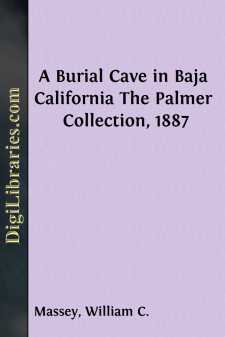Categories
- Antiques & Collectibles 13
- Architecture 36
- Art 48
- Bibles 22
- Biography & Autobiography 813
- Body, Mind & Spirit 142
- Business & Economics 28
- Children's Books 17
- Children's Fiction 14
- Computers 4
- Cooking 94
- Crafts & Hobbies 4
- Drama 346
- Education 46
- Family & Relationships 57
- Fiction 11829
- Games 19
- Gardening 17
- Health & Fitness 34
- History 1377
- House & Home 1
- Humor 147
- Juvenile Fiction 1873
- Juvenile Nonfiction 202
- Language Arts & Disciplines 88
- Law 16
- Literary Collections 686
- Literary Criticism 179
- Mathematics 13
- Medical 41
- Music 40
- Nature 179
- Non-Classifiable 1768
- Performing Arts 7
- Periodicals 1453
- Philosophy 64
- Photography 2
- Poetry 896
- Political Science 203
- Psychology 42
- Reference 154
- Religion 513
- Science 126
- Self-Help 84
- Social Science 81
- Sports & Recreation 34
- Study Aids 3
- Technology & Engineering 59
- Transportation 23
- Travel 463
- True Crime 29
A Burial Cave in Baja California The Palmer Collection, 1887
Categories:
Description:
Excerpt
In December of 1887 Dr. Edward Palmer, the naturalist, set sail from the port of Guaymas in Sonora, crossed the Gulf of California, and landed at BahÃa de Los Angeles on the peninsula of Baja California. Then, as now, there was a modest gold-mining operation at the bay. During his brief stay at the mining station, Dr. Palmer excavated a small natural cave which had been used by the Indians who were then extinct in that part of the peninsula.
Seven partially disturbed skeletons and a variety of associated artifacts were collected and deposited at the United States National Museum. The collection also included some potsherds and shells from a midden on the shores of the bay. All of these items were listed and briefly described in the Annual Report of the United States National Museum for the year 1888 (pp. 127-129).
Aside from the intrinsic value of presenting archaeological material from the little-known area of Baja California, the Palmer Collection has particular importance because of its immediate geographic source. BahÃa de Los Angeles lies in that part of Baja California most accessible to the Mexican mainland (
). Not only is there a relative physical closeness, but the Gulf islands form here a series of “stepping stones” from BahÃa de Los Angeles across to Tiburon Island, home of the Seri, and thence to the adjacent mainland coast of Sonora.The bay lies in the north-central desert region of the peninsula, where the environment is especially difficult because of extreme aridity, scarcity of surface water, and the consequent dearth of plant and animal life.
In view of these conditions, it has been suggested that the Seri may be descendants of people who, hard-pressed by the environmental poverty of this section of Baja California, may have moved across the Gulf to Tiburon Island and Sonora (Kroeber, 1931, pp. 5, 49-50). This hypothesis has appealed to one California archaeologist, although at present there is insufficient evidence from archaeology or ethnography either to support or to deny it (Rogers, 1945, p. 194). However, the archaeological collection from BahÃa de Los Angeles does indicate trade and some contact across the Gulf.
In this paper emphasis is placed on the evaluation of the Palmer Collection with respect to the known archaeology and ethnography of Baja California.
The Indians who inhabited the area surrounding BahÃa de Los Angeles spoke the Borjeño language of the Peninsular Yuman group, of the Yuman Family of languages (). They were linguistically and historically related to other Yuman-speaking groups of the peninsula and areas to the north (Massey, 1949, p. 292). At the time of European contact these people—like all other aboriginal groups on the peninsula—were hunters, fishers, and gatherers. The nearest agricultural tribes were on the lower Colorado River.
Culturally, the Borjeño were like other Peninsular Yumans of relatively late prehistoric and historic periods in central Baja California....


